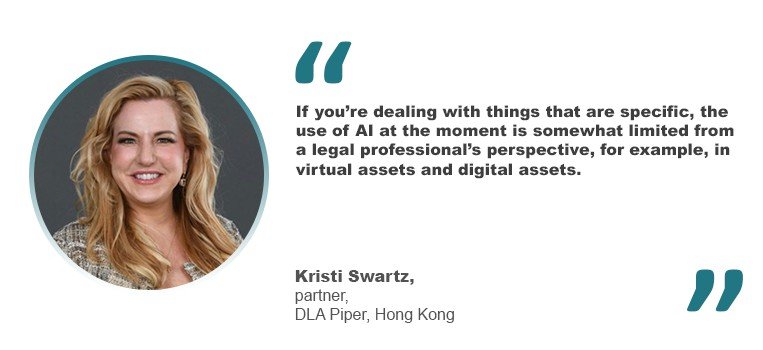“If you’re dealing with things that are specific, the use of AI at the moment is somewhat limited from a legal professional’s perspective, for example, in virtual assets and digital assets,” said Kristi Swartz, a partner at DLA Piper in Hong Kong. Swartz, an experienced fintech lawyer, noted that information about virtual and digital assets is not always true or accurate. This is particularly due to the fast-changing and fast-paced nature of fintech, which remains a relatively new and evolving area of law.
Swartz said that much of what AI currently accomplishes is reducing the time lawyers spend on processing tasks. This efficiency allows lawyers to focus more on value-added work, enhancing their overall effectiveness.
DLA Piper has also gained recognition for its in-house development of a generative AI-powered legal assistant named ButterflAI, which is designed to ensure the security and confidentiality of client work.
The legal AI market is booming, with a wave of tools emerging to streamline routine tasks, though many offer similar capabilities. Among them, Harvey AI has carved out a niche as a generative AI platform designed exclusively for legal professionals. Built on OpenAI’s cutting-edge GPT-4 model, Harvey AI specializes in legal research, document analysis, summarization, draft writing and support for both transactional law and litigation.
The AI landscape, however, is crowded and fiercely competitive. In February 2025, Legaltech Hub listed over 80 AI-powered legal assistants, most of which provide overlapping features like document summarization, Q&A, redlining and legal research. For buyers, the market can feel overwhelming and opaque. Identifying the right tool for a firm’s specific needs often requires resource-intensive side-by-side pilot testing – a process that is costly, time-consuming and typically accessible only to the largest firms with the budget and bandwidth to invest.
Despite these challenges, the potential of AI to transform the legal profession remains undeniable. Established legal technology providers such as LexisNexis and Thomson Reuters have launched their AI-powered solutions, often developed in collaboration with leading law firms. This trend is not limited to Western markets; adoption is also gaining momentum in Asia. For example, firms like Taiwan’s LCS & Partners, Thailand’s Kudun & Partners and Japan’s Atsumi & Sakai are actively integrating AI into their workflows. In mainland China, tools such as MetaLaw and Tongyi-Farui (developed by Alibaba’s Damo Academy) are being used for legal analysis, reflecting the region’s growing emphasis on legal tech innovation.
As AI adoption grows, regulators worldwide are stepping in to establish frameworks that balance innovation with accountability. On the governance front, the regulatory landscape is evolving rapidly. The European Union has enacted the AI Act, which came into force in August 2024. In the United States, a sweeping Executive Order was issued in January 2025 to regulate AI systems. The Council of Europe has also adopted the first international treaty on AI, ensuring that AI systems respect human rights and the rule of law. Meanwhile, China has ambitious plans for AI regulation, with several measures already in place and a comprehensive AI law in the works.
As the legal industry navigates this transformative era, one thing is clear: AI is no longer a distant possibility but a present reality. Whether AI becomes the ultimate legal assistant or remains a powerful but limited tool depends on how firms adapt to its strengths and address its shortcomings. For now, the lawyer reviewing contracts with Harvey AI is a glimpse into a future where technology and tradition work hand in hand – a future that is already here.
“A pen is my brain, and I can’t think if I don’t have a pen in my hand. The new generation does not think like that at all,” said Swartz. She anticipates that the next generation of legal professionals will learn, process information, and approach problem-solving in fundamentally different ways, shaped by the tools and technologies of the digital age.










